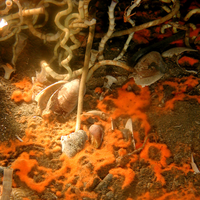12th September 2013.
A recent paper in Nature Geoscience has reviewed methane dynamics on the ocean floor around cold seeps. Cold seeps (or cold vents) are caused by tectonic activity and are quite different to the better known hydrothermal vents, although both ecosystems rely on chemosynthesis, not photosynthesis. Numerous extremophile species colonise these habitats, including deep sea mussels and tubeworms. Various types of cold seeps exist, such as pockmarks, mud volcanoes and subsurface gas chimneys, and they are frequently associated with gas hydrates.
Anaerobic oxidation of methane (AOM) is very high in these systems, which creates end-products of sulphide and dissolved inorganic carbon (DIC), leading to the build-up of carbonate structures. As well as AOM, aerobic respiration of methane takes place on surface sediments, or via methanotrophs living in symbiosis with invertebrates.
Usually methane flux on the sea bed decreases as water depth increases, but around cold seeps (which can be found at water depths of up to 3000 m) there is no trend, and this is caused by the differences in geology between seeps. Dissolved methane fluxes at cold seeps have been found to range from 3-1226 mmol CH4 m-2 d-1 but the authors point out that these are complex ecosystems that exhibit considerable spatial and temporal variations in flux. Additionally, gaseous methane is released, and larger amounts of this can escape consumption at the seep. The total flux (dissolved and gaseous) that enters the hydrosphere will either be consumed within the water column or released into the atmosphere. The authors’ calculation is that this total amounts to an annual figure of 0.02 Gt C.
As a conclusion, the paper calls for more research into these deep-sea systems due to their importance in methane cycling as well as their biological richness, and the fact that they are often found in areas prime for future industrial gas hydrate extraction.
Reference: Boetius, A., Wenzhöfer, F. 2013. Seafloor oxygen consumption fuelled by methane from cold seeps. Nature Geoscience, 6, 725-735.
Photo by Ian MacDonald. An aggregation of Lamellibrachia luymesi in the Gulf of Mexico. Source: Tubeworm May Live Longer by Cycling Its Sulfur Downward. PLoS Biol 3/3/2005: e108. http://dx.doi.org/10.1371/journal.pbio.0030108
